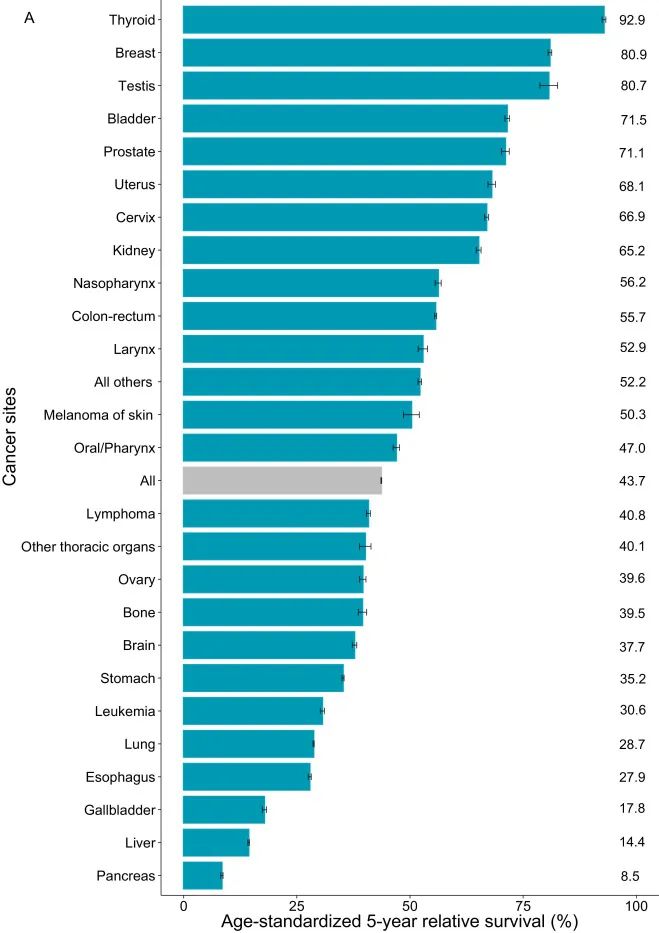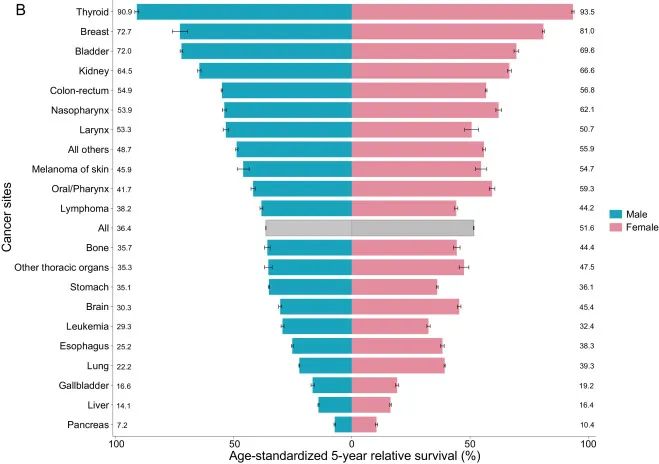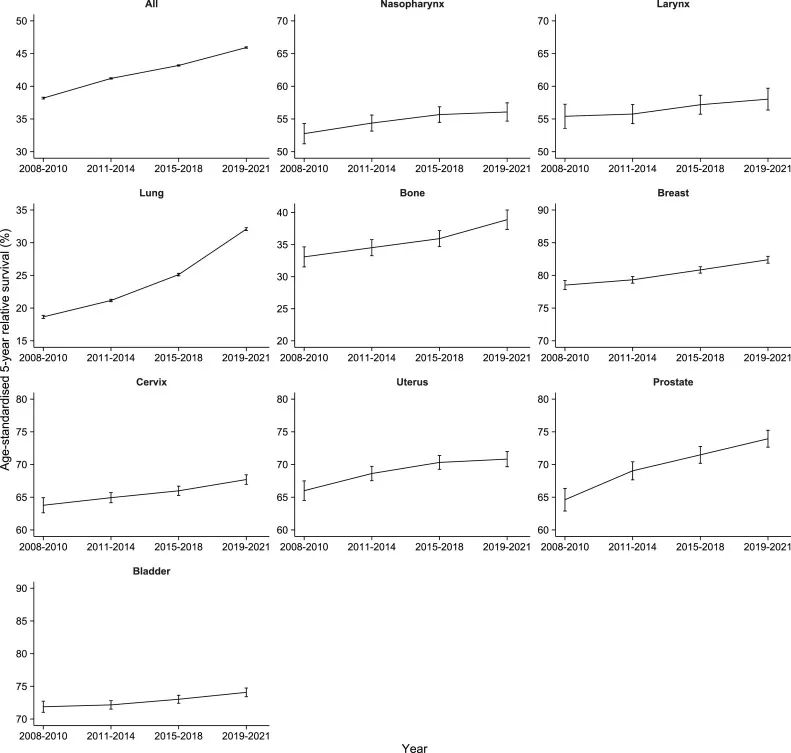Recently, the National Cancer Center released a comprehensive analysis of cancer survival rates in China from 2019 to 2021 in its official journal, Journal of National Cancer Center (JNCC). This new dataset includes information from 281 cancer registries across 31 provinces, representing a significant expansion in coverage compared to prior 2012–2015 statistics. This analysis offers an enhanced perspective on the current survival outcomes for Chinese cancer patients, serving as a critical reference for forecasting survival trends across cancer types and establishing standardized management protocols for cancer care.

Male Cancer Survival Rates Generally Lower; Lung Cancer Shows Most Improvement
The study incorporated 6,410,940 newly diagnosed cancer cases from 281 national cancer registries between 2008 and 2019. The five most common cancers were lung cancer (20.8%), colorectal cancer (10.4%), stomach cancer (9.9%), liver cancer (8.6%), and breast cancer (7.7%).
Summary of 5-Year Survival Rates for Common Cancers
The analysis revealed that the age-standardized 5-year relative survival rate for the entire Chinese population from 2019 to 2021 stood at 43.7%. Among various cancer types, substantial survival rate differences emerged. Thyroid cancer had the highest 5-year survival rate at 92.9% (95% CI: 92.4%–93.3%), while pancreatic cancer had the lowest at 8.5% (95% CI: 8.2%–8.7%).

Eight cancers recorded 5-year survival rates above 60%, including thyroid cancer (92.9%), breast cancer (80.9%), testicular cancer (80.7%), bladder cancer (71.5%), prostate cancer (71.1%), kidney cancer (65.2%), uterine cancer (68.1%), and cervical cancer (66.9%). Meanwhile, five cancers had 5-year survival rates below 30%, including pancreatic cancer (8.5%), liver cancer (14.4%), gallbladder cancer (17.8%), esophageal cancer (27.9%), and lung cancer (28.7%).
Male Patients Face Lower Survival Rates Than Female Patients, and Older Patients Have the Poorest Prognosis
Gender-based analysis showed that survival rates were generally lower for male cancer patients than female patients (36.4% vs. 51.6%). The disparity was especially marked in oropharyngeal cancer, esophageal cancer, lung cancer, and brain tumors, where the survival difference exceeded 10% between genders. Among reproductive system-related cancers, testicular and prostate cancers had 5-year survival rates of 80.7% and 71.1%, respectively, while ovarian, uterine, and cervical cancers had rates of 39.6%, 68.1%, and 66.9%, respectively.

An age-based analysis further revealed that overall survival rates and the survival rates for most cancer types decreased with age. Patients over 75 had the lowest survival rates, with a 5-year relative survival rate of only 24.1%, whereas the rate for those under 45 was as high as 76.8%. Interestingly, for prostate, stomach, colorectal, and laryngeal cancers, patients under 45 had lower survival rates than those in the 45–54 age group.

Lung Cancer Survival Improves Markedly, Thanks to Early Detection Initiatives
Between 2008 and 2021, China saw notable improvements in overall cancer control, with significant gains in the survival rates of lung, prostate, bone, endometrial, breast, cervical, nasopharyngeal, laryngeal, and bladder cancers. Lung cancer survival, in particular, increased the most, with a 4.5% improvement.
Early screening has been pivotal in raising the proportion of stage I lung cancer patients among all lung cancer cases. Additionally, increased government investment in cancer prevention, public health services, the advent of new treatment options like targeted and immunotherapies, and greater accessibility to cancer drugs through the national health insurance system have collectively boosted lung cancer survival rates.
Key Indicators and Future Trends in Cancer Survival and Control
Whether a cancer patient can achieve long-term survival depends on various factors, including the cancer’s histological type, clinical stage, timely treatment, follow-up management, and psychosocial support. Both exploratory clinical research and retrospective real-world analyses assess the efficacy of treatment options and survival benefits through multiple indicators, with the 5-year survival rate providing the most predictive value for long-term outcomes.
Current research suggests that most cancers have peak recurrence and metastasis rates within 2–3 years post-treatment. If patients reach the 5-year mark, the risk of recurrence significantly diminishes, allowing for less frequent monitoring—a state closely resembling clinical remission.
While China has made substantial progress in cancer survival across various types, challenges remain, particularly in economically disadvantaged regions where early diagnosis and screening awareness need improvement. Meanwhile, survival rates for difficult-to-treat cancers, such as pancreatic and gallbladder cancers, remain low. Improving cancer survival will require sustained advancements in healthcare coverage, biomedical research, and pharmaceutical innovations, underpinned by large-scale, population-based datasets.
With the continuous expansion of screening programs and the improved accessibility of cancer treatments, especially for economically disadvantaged populations, the outlook for Chinese cancer patients will continue to improve. The latest survival data affirm China’s strides in cancer care and highlight a promising future for cancer prevention, early diagnosis, and treatment.


 (+86)18613012387
(+86)18613012387 info@royallee.cn
info@royallee.cn EN
EN CN
CN TH
TH IDN
IDN  AR
AR





